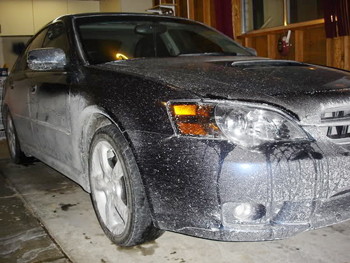If there is anything that drives a car enthusiast crazy during the winter months it’s road salt…. It’s so nasty, does terrible things to our vechicles and looks so disgusting when it dries and leaves that gross white film all over. Road salt is something that needs to be removed from your vehicle as often as possible and if you live in an area where salt is frequently used to improve road conditions, you know how difficult it can be to keep your car clean. Unfortunately, this is not something that is done regularly, and vehicle owners are constantly surprised when spring rolls around and suddenly they see spots of rust or other damage where a pristine paint job appeared only a few months earlier. The reason for this is fairly simple. Salt—particularly the salt that is used on roadways—is a caustic substance that can eat away at other substances over time. If salt is left on a car, or even on the upholstery of a car, there is going to be noticeable damage.
Though cleaning is not something that anyone really looks forward to, removing road salt is important and anyone can do it with just a little time. Properly removing all the road salt that seems to accumulate on your car during the winter months is easy if you simply use these guidelines.
•Exterior. Probably the single easiest task when it comes to cleaning your car. During the winter months you want to keep an eye out for ways to work smarter, not harder. Take advantage of those automatic car washes. They will remove a vast majority of the road salt from your exterior. The best part of this is that you won’t run the risk of hypothermia when cleaning! On average you should get your car washed within three days of any salting to cut down the risk of rust and paint damage. Doing this is also going to help protect your undercarriage and wheels, since many automatic car washes also get these portions of the vehicle at the same time. Be sure to do this when the weather is abve freezing temps though, washing and letting the left over water freeze on the vechicle can do it’s own amount of damage. If you have a garage you can piull into after a wash, that is the best scenerio.
•Leather Upholstery. If you have leather upholstery, you’ll want to clean them regularly during the winter months to remove any road salt that has come in contact with the seats. Use a soft-bristled brush to remove any loose salt and grime. Use some leather cleaning solution (similar to the kind used for soft leather boots and shoes) and a soft white cloth to apply it. Rub gently but firmly until any stains are removed. Apply a leather protectant similar to the ones used for leather boots or shoes. Allow your leather upholstery to dry, keeping it warm enough to dry and not freeze.
•Fabric Upholstery. The best way to clean road salt from fabric upholstery is similar to what you do for leather. Dry brush all the loose gunk off the seats. Simply lift the floor mats up and out. For the ground-in junk, use a 50/50 solution of white vinegar and water. Apply it to your upholstery with a sponge and wipe away. The vinegar is going to simply dissolve the ground-in junk and clean the stain at the same time.
So take a few extra minutes every now and then during these winter months to keep your driver looking it’s best, and will protect your investment for years down the road!

